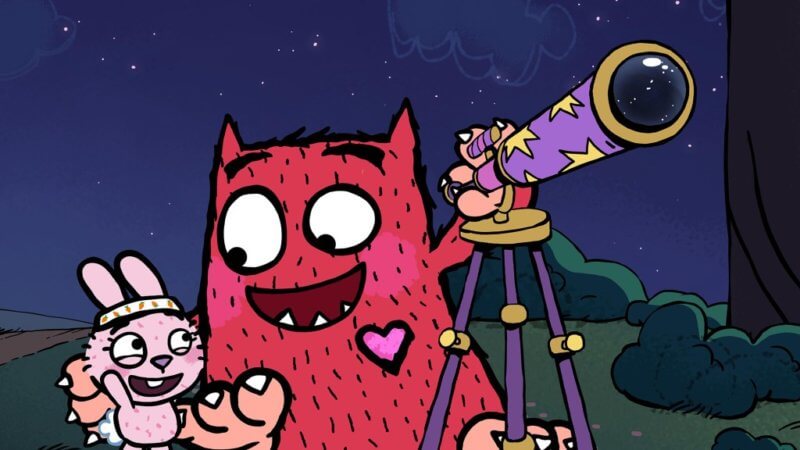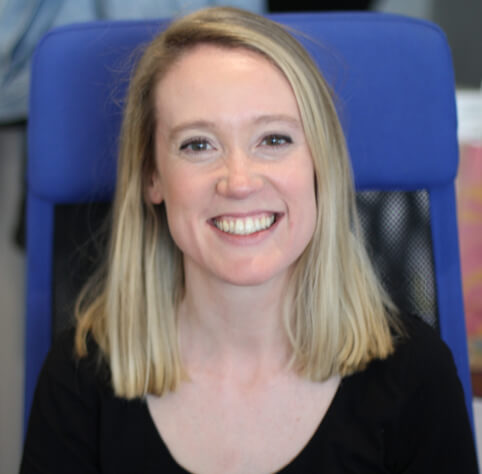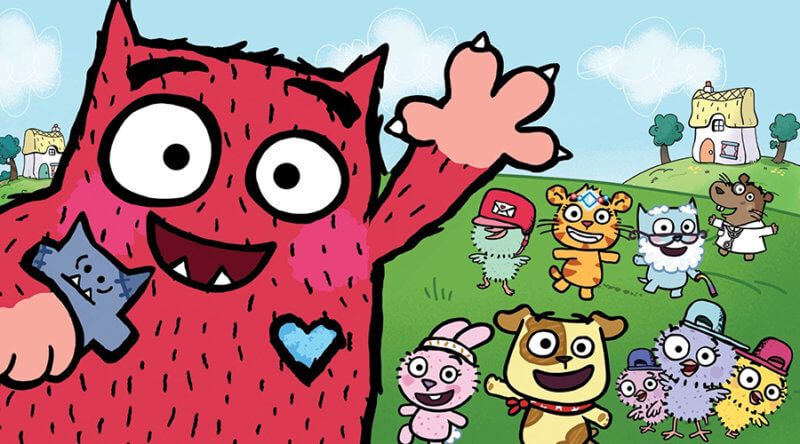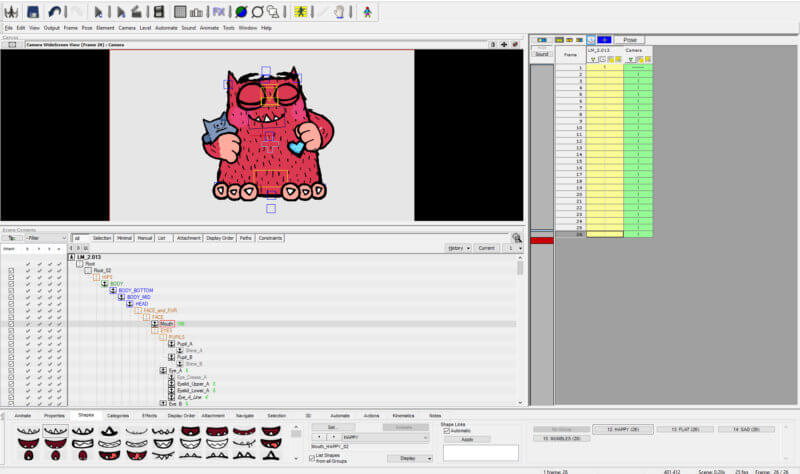Q&A with Joanna Hepworth, Animation Director on ‘Love Monster’
Last week saw the launch of Love Monster, a new animated series for preschool audiences developed from the best-selling books by British author and illustrator Rachel Bright.
With an emphasis on “the importance of kindness, empathy, connection and instinct”, the series follows the adventures of the titular Love Monster as he deals with looking out of place in the world of Fluffy Town alongside an assortment of unique companions, promoting emotional engagement and comprehension in its young audience.
Each day brings an exciting new occasion or event such as Sharing With Others Day, Build A Snowman Day or Hot Chocolate Day. Love Monster is always very excited to join in, but often finds that by trying too hard to follow his over-thinky head rather than his heart, things can go wrong… but with a lot of help from his friends and a little serendipity, he discovers how to make things right in the end, and follow his heart while building his inner confidence.

Love Monster (CBeebies)
The show, which features the voice talents of George Takei (The Missing Scarf), Sarah Hadland (Bob the Builder) and Tamsin Greig (The Tiger Who Came To Tea) among others, launched on CBeebies on January 27th and will roll out 54 episodes over the coming months.
Exec produced by Tony Reed for the BBC, Chapman Maddox for Boat Rocker Studios and James Chen Gu for UYoung, Love Monster‘s animation production helmed by Series Director Rufus Blacklock is uniquely split among Karrot Animation in London and A Productions in Bristol. Heading up the Bristol animation team is Animation Director Joanna Hepworth, whose experience in series and broadcast animation includes Nina Needs To Go (DisneyJr/ArthurCox), Doctor Who: The Macra Terror (BBC Worldwide/Sun & Moon) and Kit & Pup (CBeebies/Sun & Moon) on top of a wide variety of commercials, campaigns and short films. Skwigly spoke with Jo to learn more about the origins of Love Monster and the unique production approach that has brought it together.

Joanna Hepworth
Can you tell us a bit about your general background in animation leading up to your current role?
I studied Illustration with an Animation pathway at the University of the West of England in Bristol. Then after graduating I did some work experience and got my first job at Aardman about a year later. From there I slowly built up freelance connections, working mainly for companies in Bristol as an animator. Since then I’ve had a couple of senior roles at various companies including Sun & Moon, which came just before this current job at A Productions as Animation Director. So Love Monster is the first animation direction job on a series I’ve had, but before that I was a senior and lead on some other projects.
And you’d done some directing as well?
Yeah, throughout my career from graduating I’d directed a few things, on and off, but nothing as big as a series, more sort of short-form projects.
Are there any examples of series work or other projects before this that you are particularly proud of or learned from?
Yeah, definitely. The biggest one, and probably because it’s also the most recent, was Lead Animator on Kit & Pup for CBeebies with the BBC and Sun & Moon. That was great, because I’d done series work before but this was one of the biggest I’d worked on at the time. The schedule was just so much tighter than what I’d been used to, really high quality while having to get it out super quick. So yeah, Kit & Pup was definitely something that trained me up a little bit beforehand.
What would you say is the main premise of – and audience for – Love Monster?
So the target audience for the series – as well as the original books – is preschoolers. The world of Love Monster is from a series of books by Rachel Bright, so she’s been involved in a lot of the stages. Love Monster himself is a lovable creature who learns with his friends about how to deal with difficult situations. He lives in Fluffy Town with Tiniest Fluffiest Bunny, Bad Idea Puppy, Elder Kitten and a huge amount of other friends who all help him work out everyday problems that hopefully will be reflective of concepts children might encounter – like sharing with other people, or things they might be scared of.
So as to your specific role on this series, can you describe it and break down what it entails?
I’m Animation Director of the Bristol team – there are two teams that are in charge of the animation. There’s Karrot in London and another here at A Productions. Our team is mirrored so there’s also an Animation Director at their end. I oversee a small team of animators, dealing with everything from shot allocation, reviewing everyone’s shots, to having to deal with fixes. The big thing that I guess a lot of people don’t necessarily realise with being an Animation Director is that there’s quite a big production side to it; people manage their own time, but you help and shuffle things around if people aren’t getting stuff done in time or there are harder shots. Also just making sure that Edit have got everything that they need.
The slight difference with this production compared to one that’s entirely done with one studio is that the Series Director (Rufus Blacklock) is based in London, so we’ll have a brief before we start an episode that everyone’s involved in so we know what’s expected from him. Then Rufus and I will have separate reviews, going over keys and full animation, but it’s also my job to reflect what he wants to get from the scene without him being there. So there’s problem-solving because he’s obviously so busy and isn’t there instantly to be able to answer questions, so I’ve got to be able to work out what I’d imagine he’d want from something and direct the animators accordingly.
I also talk with the riggers very briefly – they’re very experienced and know what they’re doing but sometimes they’ll have questions about how something needs to be rigged. I don’t have a huge amount of a say in that, just occasionally.

Love Monster (CBeebies)
What’s the software?
It’s CelAction.
How have you found that?
We have a team of, at the moment, six animators, sometimes seven. When we started we had five animators and only two of us had actually used the software before, so we learned it as we were going after a bit of prep time. It is a really great software for series work, and especially on a production where things can change all the time; when you’re on a long form series, stuff you’ve started off with doesn’t necessarily carry on through to the end. For example, you might realise that there are certain shapes that don’t work or certain shapes that you need, but being able to apply that to everything in a way that’s almost automatic is amazing. So there’s some really big plus points for working in a series, but like with any software there are things that we’re either just not used to or things we like from other software that we wish were in CelAction, but I’m super proud of everybody on the production for picking it up as quickly as they did.
With this particular production a lot of people have experience with puppet animation where you’ve got arms, legs, heads and knees that all work like a person works, which is the case for the majority of our characters, but Love Monster himself has a rig that is more adaptable with a lot of control points. So basically if you approach it like it’s your usual puppet animation but then you realise you’ve got this rig that allows you to do anything, it can be hard to keep him on-model. I think everyone has struggled with that at some point, but I think they’ve all hit their speed now.
I was watching a bit of it and I couldn’t actually pin down what the software was, it’s interesting to me because back in the day CelAction had a very distinct look. Would you say the software has changed over the years to accommodate a wider breadth of styles?
Well, the only experience I have before this was what other people had told me about other productions. It’s nice that you don’t know how it’s done, because I can’t see beyond how it looks in CelAction – but I think that it’s just a team of very clever riggers and experienced people who know how to use it. I don’t think it’s been changed for a while, but it did need somebody that knew what they were doing.
The software looks quite basic but there are so many little things that you can do – I feel like every few weeks there’s something that someone shares that none of us knew it could do. It feels like a gift when you approach a whole part of your production method in a really long-winded way and then it turns out there’s a button for it! So there’s a lot of hidden secrets.
So with the production being split between Bristol and London, from your perspective is that something that happens often? It seems unique to me.
Yeah, I’ve never worked on a production like this. Sometimes I’ve worked on shows where the design will be done somewhere else, or there’ll be stuff that’s done before, elsewhere, but to actually split it like this is something that I’ve never done before. I think what is great about the way we do it is that we don’t see these episodes as ‘ours’ and ‘theirs’, it’s the same show, and it has to look the same, but I think it’s quite morale-boosting I guess to be able to start on an episode and see it through to the end, finish it and feel like it’s yours. Although the animation teams are mirrored, at the beginning design was just in London at Karrot, and then we had the edit team, so for anything design related we had a much smaller rigging team that just dealt with anything that was episodic, then all of the edit comes to us. That’s still kind of how it works, but we’ve also got UYoung in China who deal with some other aspects, but all the animation is in Bristol and London. It is an unusual way of doing things, it’s not super easy but I guess having that team split up makes it a bit more peaceful because you just don’t have as many people all after the same thing in one studio.
I imagine then the consistent look between the two teams has to be a big concern?
At the beginning, when it felt like we had more time, we’d all do reviews together, so when Karrot were having their reviews I’d be there and vice versa – as time has gone on we just don’t have time to do that. Another good thing about CelAction is you’re able to create a library of actions and poses which is amazing, so originally I’d have printouts of all these poses I liked that I’d give to all the animators so that they could reference them, but we now have them built into the rig. So when you bring that in you’ve got all these approved poses, as well as walk cycles, which are very easy to share but due to time constraints you need somebody to gather that together all at once. There were a few weeks at one point where Karrot very kindly grabbed everything and put them all in the rig, but since then there’s been so much new stuff so now we’ve use this Google Doc where every time we see something that we like, we screengrab and write it up so that we know that we can re-use it.
So that’s the biggest thing, style-wise, is we obviously all started separately having a few references to go on and it took a lot of time in the first few weeks to get on the same sort of level. We realised, especially after a few episodes, that the standard of animation we wanted from this was higher than what we were originally aiming for, mainly because of all the things we were able to do with the rig, and some people producing some great stuff – we don’t want that to change, but obviously we’ve got time constraints.
So it’s a lot easier now and I feel that, as it goes on, you really can’t tell what episode was done by which studio, which was what we were hoping for, so it’s really good to see.
Has Rachel Bright seen how it’s come together?
She’s seen it and been involved the whole way through, so she watches the episodes when they’re done and gives her opinion on them. We had a screening in London before it aired, just a small cast and crew screening and she was also there and seems to really like it, so that’s good! She’s always very positive, which is lovely.
Episodes of Love Monster are broadcast weekdays at 4pm on CBeebies and available to stream on BBC iPlayer


